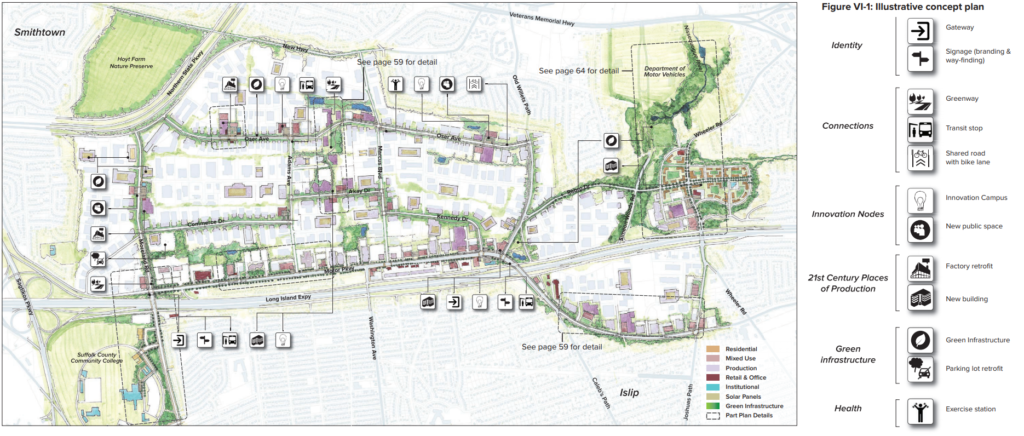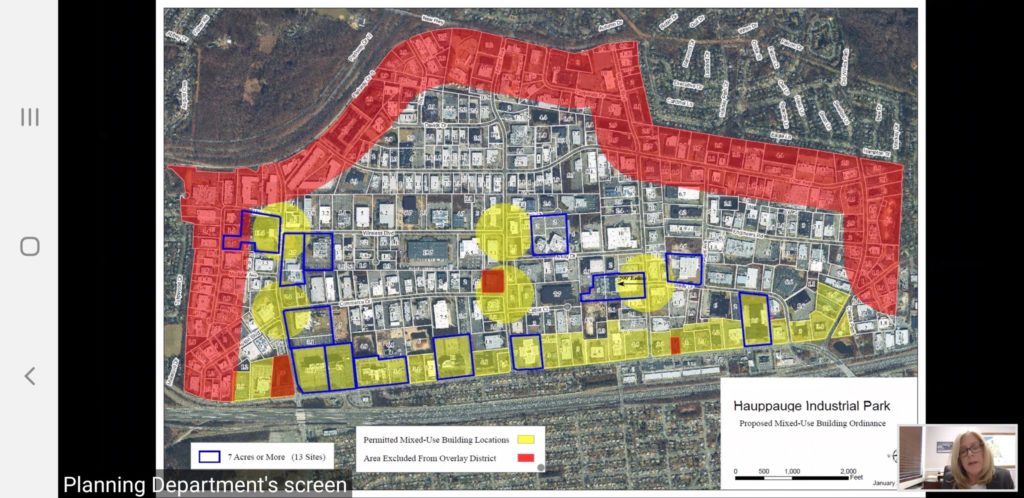The following was exclusively published by The Foggiest Idea on June 16, 2020. Interested in supporting The Foggiest Idea’s award-winning reporting and analysis? Click here.
By Richard Murdocco
Due to concerns over the coronavirus pandemic, the Smithtown Town Board held a virtual public hearing in May on a hot local topic: placing up to a thousand apartments within the bounds of what was once known as the Hauppauge Industrial Park.
Smithtown’s policymakers are currently considering a rezoning proposal that would allow for mixed-use projects that could include newly constructed residential units within the 1,650-acre confines of the industrial area. The zoning overlay is the by-product of a joint study between the Regional Plan Association and Suffolk County’s Industrial Development Agency that looked at the park’s future potential. To drum up economic activity these past few years, the Town of Smithtown has relaxed the park’s height restrictions, while Suffolk County has expanded the area’s sewage treatment. The park has also been rebranded. Its new name is officially the Long Island Innovation Park at Hauppauge.
The most recent proposal would permit a mixture of uses on 13 of Hauppauge’s 450 parcels that are seven acres or larger. If approved, most of the new growth would have frontage on Motor Parkway, which rings the industrial area’s southern border, and along other key roads that would be strategically chosen so whatever development occurs would take place away from local homes. As of this writing, some of the properties targeted by the zoning overlay already either have tenants or are owner-occupied, and no active proposals have been pitched by builders. But knowledgeable sources tell The Foggiest Idea that some developers have already expressed interest in building there.
This mixed-use concept has been kicking around in the heads of the park’s lobbying group, the Hauppauge Industrial Association of Long Island (HIA-LI), for years as similar industrial conversions have begun in other municipalities. In Melville, the Town of Huntington has explored a similar concept along the Route 110 corridor, while New Jersey developers have worked to revamp their increasingly vacant office spaces into something more supposedly “millennial-friendly.”

Pictured: An illustrated conceptual plan for the 1,650-acre Long Island Innovation Park at Hauppauge. The plan was first drafted in April 2019 by James Lima Planning + Development with input by the RPA, the Suffolk County IDA, and HIA-LI. (Source: James Lima Planning + Development)
Despite the pandemic-induced lockdown, some Smithtown residents were not happy that the town board broached the controversial rezoning proposal on a Zoom video conference held on a Thursday afternoon in May.
One speaker, who identified as “a Hauppauge local,” told the town board that holding the May 21st hearing at 2 p.m. was “offensive.”
That sentiment was not uncommon.
“I found out about this twenty-minutes before this meeting,” said another resident who claimed to live in a nearby subdivision. “My neighbors in the community are very upset.”
David Barshay, president of the Hauppauge Board of Education since 2013, complained that the public hearing reflected “a complete lack of transparency on behalf of the board.” He cited his own board’s open practices as an example of what should be done, adding, “You have an obligation to answer questions live.”
Barshay disputed any assumption that the school district could readily absorb more students from additional development, calling that notion “disingenuous at best and uninformed at worst,” because future public education funding remains murky considering the pandemic’s impact on the state budget.
“Give us time to figure out if we can even absorb these kids,” Barshay said. Notably, in the days before the hearing, the Hauppauge school district wrote to the Town’s policymakers asking that the virtual forum be delayed to give the board of education more time to study the rezoning proposal.
Throughout the public hearing, Smithtown Town Supervisor Edward Wehrheim repeatedly tried to reassure local residents that the Hauppauge mixed-use proposal was theoretical, but to no avail.
Not surprisingly, the majority of those who spoke out in favor of the overlay rezoning were developer types already doing business in the industrial complex.
“We’re very fortunate to have this zoning proposal before us,” said Jim Coughlan of Setauket-based Tritec Real Estate adding that the Hauppauge school district has been losing kids for years. Tritec owns buildable land within the industrial park.
“The park has brought in some great companies in the last 40 years, and we want to continue bringing those great companies,” said Robert Mannino, chief operating officer of the Kulka Group, whose founder, Jack Kulka, was one of the industrial park’s earliest proponents and developers. According to Mannino, it is second only to Silicon Valley in terms of size. A Hauppauge resident himself, Mannino applauded the town board’s timing of the meeting and said that the public hearing was the first time he heard that local schools were overcrowded.

Pictured above: Areas of potential development are highlighted in yellow within the Hauppauge Industrial Park, as shown during the virtual town board meeting held on May 21, 2020 (Source: Town of Smithtown).
But not every builder supports applying the mixed-use concept.
Developer Jerry Wolkoff, hoping to break ground for the first phase of his massive Heartland Town Square project in nearby Brentwood, told The Foggiest Idea that the Hauppauge industrial park should focus on job creation, not on housing development.
“Personally, I think what they’re doing now to create jobs is more important there,” he said, adding that he’s creating more than enough housing at Heartland’s Pilgrim State location. If it ever is fully developed, as expected within the next 30 years or so after the first phase was approved in 2017, Wolkoff’s project would include around 9,000 residential units. The builder was blunt when it comes to the industrial park’s current usage. “I think it should stay that way,” Wolkoff declared.
A county planning official, who spoke to TFI on the condition of anonymity in order to be candid, called the RPA and IDA’s proposal for the park “sterile.”
“This is the opposite of downtown revitalization,” they said, noting that any new neighborhood built within the industrial park would lack key community services. “You’re creating an isolated community with no context. I don’t know where they came up with this,” the official said.
According to the official, the proposal for Hauppauge is “meant to benefit a couple of people who couldn’t sell their land and wanted to do something with it.” They also expressed fear that the current economic downturn as a result of the coronavirus pandemic will be used as an excuse by development advocates and the HIA-LI to push the zoning overlay through. “We’re giving up industrial land for residences and that’s not necessarily the wisest thing to do right now. Industrial land provides the most tax base,” they said. “Everybody is getting a tax abatement anyway, so there will be no economic benefit for 20 years.”
Terri Alessi-Miceli, the president of the HIA-LI, insisted that building new housing within the park would not adversely impact nearby development projects like Heartland or the Ronkonkoma Hub.
“There is such a dire need for workforce housing on Long Island that these projects are not mutually exclusive,” said Alessi in a statement provided to TFI. “We haven’t even come close to capacity level for rental housing.”
In addition, she insisted that the HIA-LI is willing to work with everyone, including the school district.
“Along with the Town of Smithtown and whoever is chosen as the developer,” she wrote, “we plan on putting in place a totally transparent process that engages the local community, its leaders and stakeholders.”
Mitch Pally, chief executive officer of the pro-development Long Island Builders Institute, expressed bewilderment about the Hauppauge school district’s opposition to the rezoning proposal, calling concerns about increasing enrollment and worsening traffic “a misnomer” and “a political statement by people who do not understand.”
“That school district has the fourth lowest tax rate of any school district in Suffolk County outside of the East End,” he told TFI, adding that Hauppauge’s enrollment has dropped by 100 students or so within the last year. Pally estimated that the industrial park provides around $44 million annually to local schools. “The people who are going to be living in the park are most likely people working in the park,” he said. According to Pally, providing new apartments at the industrial park won’t lead to many more children students attending schools because the typical suburban amenities simply won’t be there.
“They are not going to live there with two or three children,” he said. “The school children issue is hogwash.”
Pally responded quickly when TFI asked him if the conversion of much-coveted industrial space, which is in short supply throughout the Northeast, is wrong-headed.
“Many different places are moving towards the inclusion of residential,” he said. “We wanted to provide that option for those landowners who thought it was appropriate.”
According to Pally, “The amount of land available under the zoning proposal is a significantly small portion, and almost every building in the park is one story.” He added that any changes to the park’s composition must include neighborhood retail services to keep traffic impacts low.
“Now that you have the sewer connection and the town has expanded the ability to go to 60 or 65 feet high within the park, that will provide a significant investment opportunity for industrial uses,” he said. “We see it as a complement to the industrial usage and not a competition for it.”
Pally pointed out that the Town of Islip, which regulates a small portion of the industrial park’s southeastern end, is exploring ways to update their zoning to better complement what Smithtown wants to do.
During the virtual hearing, TFI also weighed in by stressing to the official policymakers that although there is no denying the marked need for more attainable housing options, past change-of-zone actions have lacked accountability in terms of ensuring that the units are available for the intended buyers: young professionals who live and work in the region.
Multiple sources later told TFI that they expect the zoning proposal to be approved sometime this summer, possibly as early next month. But it’s clear that an untold number of residents living near the Hauppauge park remain disengaged or, worse, uninformed, despite the overlay idea being years in the making.
In the home stretch of the marathon hearing in May, one Smithtown resident of 25 years asked the town board, “Is this a done deal? Has this already been done, and is this just a formality?”
Knowing how developmental matters are all too often handled on Long Island, it’s safe to say that we already know the answer.
Richard Murdocco is an award-winning columnist and adjunct professor in Stony Brook University’s public policy graduate program. He regularly writes and speaks about Long Island’s real estate development issues. Follow him on Twitter @thefoggiestidea. You can email Murdocco at Rich@TheFoggiestIdea.org.











